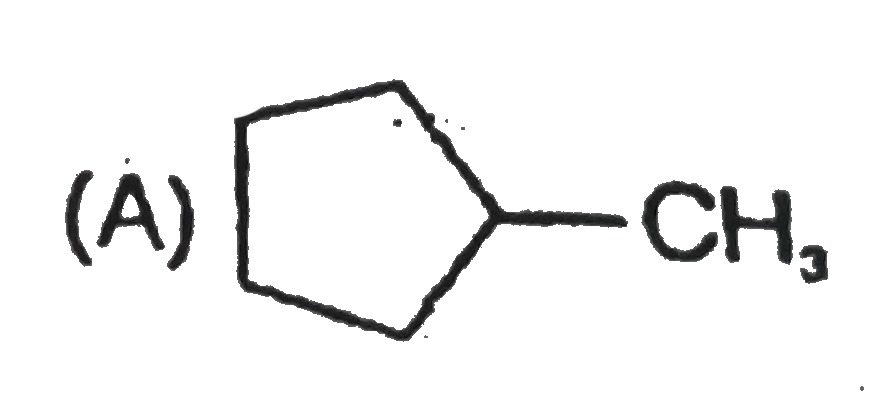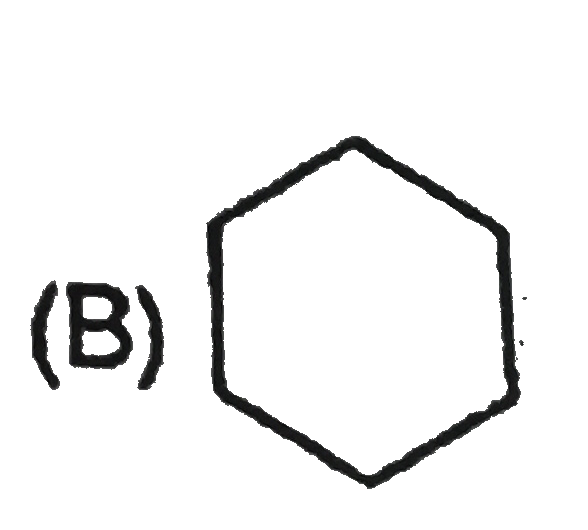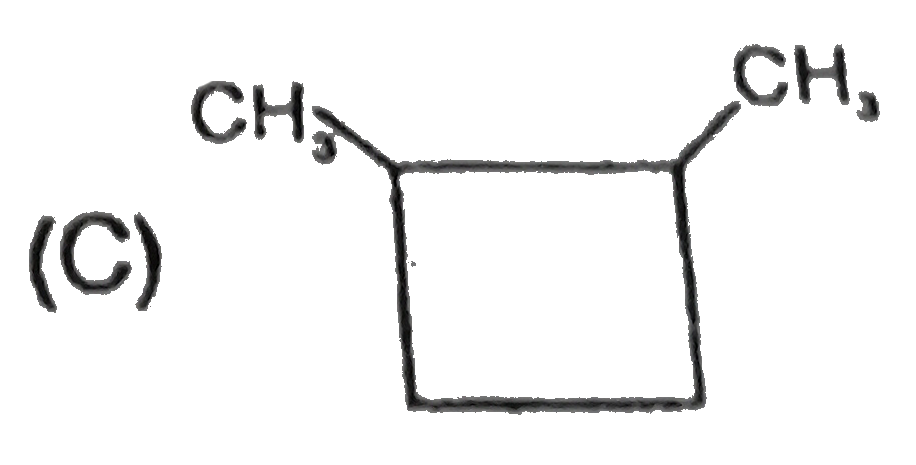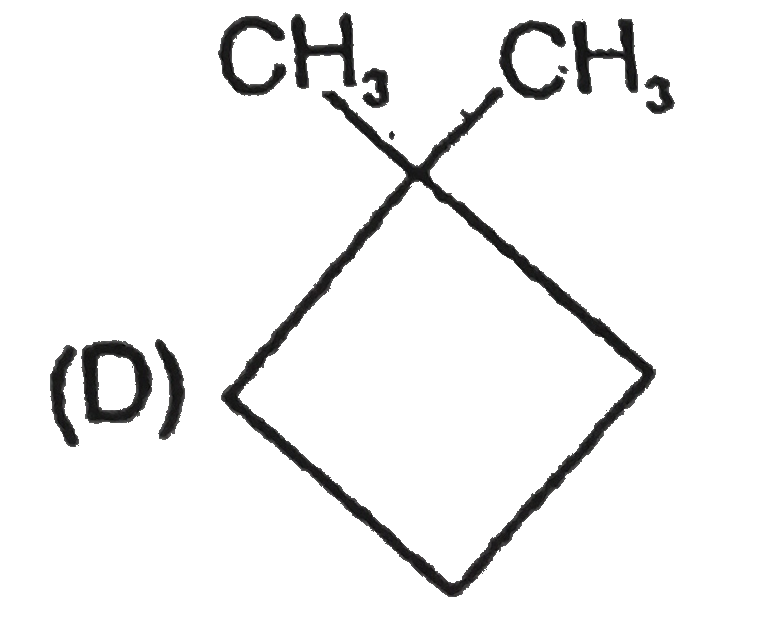A hydrocarbon (X) of the formula C6H12 does not react with bromine water but reacts with bromine in presence of light, forming compound (Y).Compound (Y) on treatment with Alc. KOH gives compound (Z) which on ozonolysis gives (T) reduces Tollens reagent which gives compound (W) after acidification . (W) gives iodoform test and after acidification produce compound (U) which when heated with P2O5 forms a cyclic anhydride (V).
Compound 'x' is




The correct Answer is:A
To solve the problem step by step, we need to analyze the information provided and deduce the structure of compound X.
Step 1: Identify Compound X
- The hydrocarbon (X) has the formula C₆H₁₂.
- It does not react with bromine water, indicating it is a saturated hydrocarbon (alkane).
- Since it reacts with bromine in the presence of light, it suggests that X is likely a cyclic alkane, specifically cyclohexane.
Hint: Look for clues in the reactivity of the compound. Saturated hydrocarbons do not react with bromine water but can react with bromine in the presence of light.
Step 2: Reaction with Bromine
- When cyclohexane (X) reacts with bromine in the presence of light, it undergoes a free radical substitution reaction, forming bromocyclohexane (Y).
Hint: Free radical reactions typically require light to initiate the process.
Step 3: Reaction with Alcoholic KOH
- The compound Y (bromocyclohexane) is treated with alcoholic KOH, leading to an elimination reaction to form an alkene (Z). The major product will be 1-hexene.
Hint: Alcoholic KOH promotes elimination reactions, leading to the formation of alkenes.
Step 4: Ozonolysis of Compound Z
- The alkene (Z) undergoes ozonolysis, which cleaves the double bond and forms an aldehyde (T) and a ketone.
Hint: Ozonolysis typically results in the formation of carbonyl compounds.
Step 5: Reduction with Tollen's Reagent
- The aldehyde (T) reduces Tollen's reagent, forming a carboxylic acid (W) after acidification.
Hint: Tollen's reagent is used to test for aldehydes and will oxidize them to carboxylic acids.
Step 6: Iodoform Test
- The compound W (the carboxylic acid) gives a positive iodoform test due to the presence of a methyl ketone group.
Hint: The iodoform test is specific for methyl ketones or compounds that can form them.
Step 7: Formation of Compound U
- After acidification, compound W forms compound U, which is a methyl ketone.
Hint: The iodoform reaction leads to the formation of a compound that can further react.
Step 8: Heating with P₂O₅
- Compound U, when heated with P₂O₅, forms a cyclic anhydride (V).
Hint: P₂O₅ is a dehydrating agent that can facilitate the formation of cyclic structures.
Conclusion
After analyzing all the steps and reactions, we conclude that compound X is cyclohexane (C₆H₁₂).
Final Answer: Compound X is cyclohexane.
- The hydrocarbon (X) has the formula C₆H₁₂.
- It does not react with bromine water, indicating it is a saturated hydrocarbon (alkane).
- Since it reacts with bromine in the presence of light, it suggests that X is likely a cyclic alkane, specifically cyclohexane.
- When cyclohexane (X) reacts with bromine in the presence of light, it undergoes a free radical substitution reaction, forming bromocyclohexane (Y).
- The compound Y (bromocyclohexane) is treated with alcoholic KOH, leading to an elimination reaction to form an alkene (Z). The major product will be 1-hexene.
- The alkene (Z) undergoes ozonolysis, which cleaves the double bond and forms an aldehyde (T) and a ketone.
- The aldehyde (T) reduces Tollen's reagent, forming a carboxylic acid (W) after acidification.
- The compound W (the carboxylic acid) gives a positive iodoform test due to the presence of a methyl ketone group.
- After acidification, compound W forms compound U, which is a methyl ketone.
- Compound U, when heated with P₂O₅, forms a cyclic anhydride (V).
After analyzing all the steps and reactions, we conclude that compound X is cyclohexane (C₆H₁₂).
Topper's Solved these Questions
Similar Questions
Knowledge Check
The compound which does not give iodoform test is
AAcetophenoneBBenzophenoneCCH3C∣CH3HOHDCH3−C∣OHH−CH2CH2CH3The compound which does not give iodoform test is
AAcetophenoneBBenzophenoneCCH3C∣CH3HOHDCH3−C∣OHH−CH2CH2CH3The compound which does not give iodoform test is
AAcetophenoneBBenzophenoneCCH3C∣CH3HOHDCH3−C∣OHH−CH2CH2CH3
Compound (X) of molecular formula C4H8 takes up one equivalent of hydrogen in presence of Pt to form another compound (Y),(X) on ozonolysis gives acetaldehyde as the only product. Compound (X) is
View SolutionThe compound which does not give iodoform on treatment with NaOH and iodine is
View SolutionThe compound which does not give iodoform on treatment with NaOH and iodine is
View SolutionThe compound which does not give iodoform on treatment with NaOH and iodine is
View SolutionPrimary alkyl halide C4H9Br (X) reacts with alc. KOH to give compound (Y). (Y) reacts with HBr to give compound (Z) which is an isomer of (X). When (X) reacts with Na metal it gives compound (P). (X), (Y), (Z) and (P) are
View Solution

